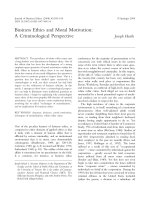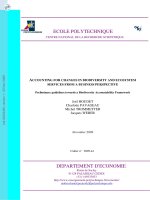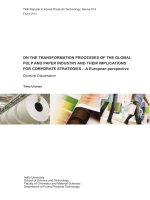Coal and Peat Fires: A Global Perspective pot
Bạn đang xem bản rút gọn của tài liệu. Xem và tải ngay bản đầy đủ của tài liệu tại đây (14.95 MB, 381 trang )
Coal and Peat Fires: A Global Perspective
Captions for Front Cover Photos
Top Photo: An underground coal fire being manually excavated in the Sungai Wain Nature Reserve on the Island
of Borneo. Underground coal beds were ignited here in 1998 by forest fires in East Kalimantan. Photo by
Alfred E. Whitehouse, 1999.
Bottom-Left Photo: A gob-pile fire started by spontaneous combustion in the Kl einkopje Colliery located in the
Witbank Coalfield, South Africa. The vertical field of view is 3 m and the foreshortened horizontal field of view is
9 m. Photo by Robert B. Finkelman, 2004.
Bottom-Middle Photo: Surface expression of an underground coal fire in the Carbonera Formation; burning in the
Lobatera Mine in Táchira State, western Venezuela. The horizontal field of view is about 120 cm. Photo by Manuel
Martínez, 2007; courtesy of Gonzalo Márquez and Manuel Martínez.
Bottom-Right Photo: Bituminous coal in the Raniganj Formation, ignited by spontaneous combustion; burning in
the opencast Kajora Mine, Raniganj Coalfield, Burdwan, West Bengal, India. The maximum thickness of the
exposed seam is approximately 2 m. Most coal seams in the Raniganj Formation are 4-5 m thick. Photo by Prasun
Gangopadhyay, 2006.
Coal and Peat Fires: A Global Perspective
Volume 1: Coal – Geology and Combustion
Edited by
Glenn B. Stracher
Division of Science and Mathematics, University System of Georgia, 131 College Circle,
Swainsboro, Georgia 30401 USA
Anupma Prakash
Geophysical Institute, University of Alaska Fairbanks, 903 Koyukuk Drive, Fairbanks,
Alaska 99775 USA
Ellina V. Sokol
Institute of Geology and Mineralogy, Siberian Branch of the Russian Academy of Sciences,
pr. Koptyuga, 3, Novosibirsk 630090 Russia
Amsterdam – Boston – Heidelberg – London – New York – Oxford – Paris
San Diego – San Francisco – Singapore – Sydney – Tokyo
Elsevier
Radarweg 29, PO Box 211, 1000 AE Amsterdam, The Netherlands
The Boulevard, Langford Lane, Kidlington, Oxford OX5 1GB, UK
First edition 2011
Copyright © 2011 Elsevier B.V. All rights reserved
No part of this publication may be reproduced, stored in a retrieval system or transmitted
in any form or by any means electronic, mechanical, photocopying, recording or other wise without the prior
written permission of the publisher
Permissions may be sought directly from Elsevier’s Science & Technology Rights
Department in Oxford, UK: phone (+44) (0) 1865 843830; fax (+44) (0)1865 853333;
email: Alternatively you can submit your request online
by visiting the Elsevier web site at />permissions, and selecting Obtaining permission to use Elsevier material
Library of Congress Cataloging-in-Publication Data
A catalog record for this book is available from the Library of Congress
British Library Cataloguing in Publication Data
A catalogue record for this book is available from the British Library
ISBN: 978-0-444-52858-2
For information on all Elsevier publications
visit our website at elsevierdirect.com
Printed and bound in United Kingdom
101110987654321
Working together to grow
libraries in developing countries
www.elsevier.com | www.bookaid.org | www.sabre.org
Dedication
We dedicate this four-volume book to Janet L. Stracher whom we love
and admire for her kindness to strangers, devotion to family and friends,
and her love of nature. Her inspirat ion and guidance throughout our
undertaking of this monumental project assured its comple tion.
v
This page intentiona lly left blank
Preface
COAL AND PEAT FIRES: A GLOBAL PERSPECTIVE, Volumes 1–4, is a comprehensive collection of diverse and
pioneering work in coal and peat-fires research conducted by scientists and engineers around the world. It contains
hundreds of magnificent color photographs, tables, charts, and multimedia presentations. Explanatory text is
balanced by visually impressive graphics.
This work is devoted to all aspects of coal and peat fires. It contains a wealth of data for the research scientist, while
remaining comprehensible to the general public interested in these catastrophic fires. Amateur and professional
mineralogists, petrologists, coal geologists, geophysicists, engineers, environmental and remote sensing scientists,
and anyone interested in coal and peat mining and coal and peat fires will find these four volumes useful. Although
the technical level varies, the science-attentive audience will be able to understand and enjoy major portions of this
work.
The four volumes are also a valuable source of information about the socioeconomic and geoenvironmental
impacts of coal and peat fires. As an example, the mineral, creosote, and select-gas analyses presented will be of
great interest to environmental scientists, academicians, people employed in industry, and anyone interested in
pollution and the by-products of combustion.
The contents of this work can be used to design and teach courses in environmental science and engineering, coal
geology, mineralogy, metamorphic processes, remote sensing, mining engineering, fire science and engineering,
etc. A variety of case studies on a country by country basis, including prehistoric and historic fires, encompass a
wide range of geoscience disciplines including mineralogy, geochemical thermodynamics, medical geology,
numerical modeling, and remote sensing, making this work a cutting edge publication in “global coal and peat-
fires science.”
Volume 1 before you contains 19 chapters illustrated in full color. Chapter 1 discusses the origin of coal and
coal fires. Chapter 2 discusses the techniques used for mining coal in addition to coal fires that occur in
association with such mining. In Chapter 3, the connection between spontaneous combustion and coal
petrology is discussed. Chapter 4 is about the utilization of coal by ancient man. Geotechnical and environ-
mental problems associated with burning coal are discussed in Chapter 5. The general effects of coal fires that
are burning around the world are discussed in Chapter 6, and Chapter 7 examines the environmental and
human-health impacts of coal fires. Chapter 8 is devoted to explaining the analytical method of gas
chromatography used to analyze samples of coal-fire gas collected in the field. Numerous complex processes
associated with the nucleation of minerals from coal-fire gas are presented i n Chapter 9, and in Chapter 10 the
analytical methods used to identify such minerals are discussed. Chapter 11 presents a synopsis of the
analytical procedures used to identify the semivolatile hydrocarbons that nucleate from coal-fire gas. In
Chapter 12, the magnetic signatures recorded by rocks and soils affected by the heat energy from burning
coal are examined. Chapter 13 presents a synopsis of the historical utilization of airborne thermal infrared
imaging for examining coal fires, and in Chapter 14 a more in-depth synopsis of the use of remote sensing
technology for studying coal fires is presented. In Chapter 15, the historical and political implications for US
government policy regarding coal fires are presented. The former US Bureau of Mines role in controlling coal
fires in abandoned mines and spoils piles is presented in Chapter 16. Chapters 17 and 18, respectively, present
engineering fire-science studies of combustion phenomena and the suppression of smoldering coal fires.
Volume 1 concludes with Chapter 19, in which the use of compressed-air-foam injection for extinguishing
coal fires is discussed.
Volume 2 presents hundreds of color photos of coal and peat fires burning around the world as well as
multimedia presentations that include movies, radio talk shows, and presentations given at professional meet-
ings. Volume 3 presents case studies about fires on a country by country basis. Volume 4 is devoted to all
aspects of peat and peat fires. An online interactive world map o f c o al a n d p eat fires i s designed to compl em ent
all four v olumes.
vii
The editors of this four-volume book believe that scientists and engineers as well as the general public will find that
the information presented herein reveals the complexity of coal and peat-fires science, the effects of these fires, and
useful methods for inves tigating them. We hope that the information presented will create global awareness about
these fires and trigger new research ideas and methods for studying them, accelerate efforts to mitigate and
extinguish them, and build a better-living environment in mining areas around the world.
viii Preface
Acknowledgments
We thank all contributors to Coal and Peat Fires: A Global Perspective, Volumes 1–4, for the submission of their
research results, photos, and multimedia materials for publication. We are grateful for the necessary permission
granted for publication by select institutions that some of our contribut ors work for. The valuable assitance of
Guest Editor Rudiger Gens with developing the interactive online world map of coal and peat fires and Guest
Editor Guillermo Rein wi th developing Volume 4 is much appreciated. We also thank all our colleagues who
helped with peer revie w of the contents. In addition, we thank Anita Koch, Linda Versteeg, Mageswaran
Babusivakumar, Greg Harris, Mónica Mendoza, and others at Elsevier who assisted in the publication of this work.
Glenn B. Stracher
Anupma Prakash
Ellina V. Sokol
ix
This page intentiona lly left blank
Contents
Volume 1: Coal – Geology and Combustion
Volume 2: Photographs and Multimedia Tours
Volume 3: Case Stud ies – Coal Fires
Volume 4: Peat – Geology, Combustion, and Case Studies
On Line: Interactive World Map of Coal and Peat Fires by Rudiger Gens
Captions for Front Cover Photos ii
Dedication v
Preface vii
Acknowledgments ix
List of Contributors xix
Chapters
1. Coal Formation and the Origin of Coal Fires 1
Ann G. Kim
1.1. The Formation of Coal 2
Introduction 2
Geologic Distribution of Coal Seams 3
Coal Swamps 5
Cyclothems 5
Coalification 6
Coal Composition 10
1.2. Origin of Coal Fires 15
Introduction 15
Incidence of Coal Fires 16
Ignition and Propagation of Coal Fires 16
Control of Coal Fires 19
Conclusions 22
Acknowledgments 23
Important Terms 23
References 24
WWW Addresses: Additional Reading 28
2. Coal-Mining Techniques and Coal Fires 29
Stanley R. Michalski
2.1. Brief History of Coal Mining 30
Introduction 30
Evolution of Coal Mining 30
Coal-Mining Techniques 31
Coal-Mining Machines 32
2.2. Underground Coal Mining 33
Underground Mining 33
Methods of Coal Mining 34
The Special Case of Anthracite Mining 36
Ventilation 36
2.3. Surface Coal Mining 37
Surface Mining 37
xi
Contour Mining 37
Area Mining 38
Auger Mining 38
Mountain Top Removal 38
2.4. Coal Mining and Coal Fires 39
Discovery and Investigation 39
Monitoring 39
Mine Atmosphere 40
Abatement 41
Acknowledgments 42
Important Terms 43
References 44
WWW Addresses: Additional Reading 45
3. Spontaneous Combustion and Coal Petrology 47
Maria Mastalerz, Agnieszka Drobniak, James C. Hower, Jennifer M.K. O’Keefe
3.1. Spontaneous Combustion and Coal Petrology 48
Introduction 48
Maceral Composition of Coal 48
Inorganic Matter in Coal 50
Microlithotypes 54
Lithotypes 54
Coal Rank 55
Coal Petrology and Spontaneous Combustion 56
Important Terms 60
References 61
WWW Addresses: Additional Reading 62
4. Coal and Ancient Man: Cremation at the Tschudi Burn, Chan Chan, Northern Peru 63
William E. Brooks, Cesar G. Mora, John C. Jackson, John P. McGeehin, Darden G. Hood
4.1. Coal and Ancient Man 64
Introduction 64
Coal in Peru 64
Chan Chan 65
Metallurgical Furnace or Crematorium 66
Temperature of the Tschudi Burn 66
Calcium in the Soil 67
Sulfur in the Soil 68
Fuel Ash Chemistry 68
Oxide and Trace Element Data 69
14
C Date 74
Cremation in Society 74
Fuel for Cremation 75
Cremation at the Tschudi Burn 76
Discussion 77
References 78
WWW Addresses: Additional Reading 81
5. Geotechnical and Environmental Problems: Coal and Spontaneous Combustion 83
Laurance J. Donnelly, Fred G. Bell
5.1. Geotechnical and Environmental Problems 84
Introduction 84
Origin of Spontaneous Combustion 85
Spontaneous Combustion: Life and Human Health 85
Coal Seam and Colliery-Spoil Heap Fires 86
Control and Preventation of Spontaneous Combustion and Coal Fires 86
Examples of Spontaneous Combustion and Coal Fires 89
Conclusions 98
Acknowledgments 99
Important Terms 99
References 99
xii Contents
6. The Effects of Global Coal Fires 101
Glenn B. Stracher, Tammy P. Taylor
6.1. The Global Catastrophe 102
Introduction 102
The Mining Hazard 103
Catastrophic Coal Fires 105
Discussion 109
Acknowledgments 110
Important Terms 110
References 110
WWW Addresses: Additional Reading 113
7. Environmental and Health Impacts of Coal Fires 115
Robert B. Finkelman, Glenn B. Stracher
7.1. Environmental and Health Impacts of Coal Fires 116
Introduction 116
Environmental Consequences 118
Health-Related Effects 121
Discussion 122
Important Terms 123
References 123
WWW Addresses: Additional Reading 125
8. Analysis of Coal-Mine-Fire Gas 127
Timothy R. Blake, Simone Meinardi, Donald R. Blake
8.1. Trace Gas Analyses 128
Introduction 128
Gas Collection 128
Sample Analyses 129
Methane System 129
CO/CO
2
System 130
VOC System 130
Quality Control: Standards 132
Modifying 133
Important Terms 133
References 133
WWW Addresses: Additional Reading 134
9. Gas Vent Mineralization and Coal Combustion 135
Glenn B. Stracher
9.1. The Origin of Gas Vent Minerals 136
Introduction 136
Mineral-Forming Processes 136
Isochemical Mineralization 136
Mass Transfer Mineralization 138
Discussion 142
9.2. Sample Collecting and Field Data 143
Introduction 143
Safety Precautions 143
GPS and Temperature Measurements 144
Mineral and Rock-Collecting Techniques 145
Gas-Collecting Techniques 147
In Situ Chemical Analyses 148
Discussion 150
Acknowledgments 151
Important Terms 151
Contents xiii
References 151
WWW Addresses: Additional Reading 152
10. Sample Identification and Imaging of Gas-Vent Mineral Assemblages 155
Paul A. Schroeder, Chris Fleisher, Glenn B. Stracher
10.1. Sample Identification and Imaging 156
Introduction 156
X-Ray Diffraction 157
Electron Microprobe 159
Short-Wave Infrared Spectroscopy 163
Other Analytical Methods 165
Comments 166
Acknowledgments 166
Important Terms 166
References 169
WWW Addresses: Additional Reading 171
11. Semivolatile Hydrocarbon Residues of Coal and Coal Tar 173
Stephen D. Emsbo-Mattingly, Scott A. Stout
11.1. Source Identification 174
Source Signatures 174
Fossil Fuels 175
Carbonization 175
Lines of Evidence 177
11.2. Sample Preparation 178
Collection 178
Extraction 178
Cleanup 179
11.3. Sample Analysis 180
Introduction 180
Total Organic Carbon 180
Total Extractable Material 180
High-Resolution Hydrocarbon Scan 181
Polycyclic Aromatic Hydrocarbons 184
Saturated Hydrocarbons 188
Geochemical Biomarkers 191
11.4. Coal-Fire Residues 193
Semivolatile Hydrocarbons 193
Dominant Hydrocarbons 193
PAH Transformations 195
Saturated Hydrocarbon Residues 198
Biomarker Stability 201
Conclusions 205
Acknowledgments 205
Important Terms 205
References 207
12. Magnetic Signatures of Rocks and Soils Affected by Burning Coal Seams 209
Robert S. Sternberg
12.1. Magnetic Signatures 210
Introduction 210
Field Work 211
Magnetic Anomalies 212
Magnetic Properties 214
Discussion 215
Acknowledgments 216
Important Terms 216
References 216
WWW Addresses: Additional Reading 218
xiv Contents
13. Historical Use of Airborne Thermal Infrared Imaging for Detecting and Studying Coal Fires 219
Daniel H. Vice
13.1. Airborne Thermal Infrared Imaging 220
Introduction 220
Thermal Infrared Imaging 220
Color Infrared Imaging 222
Early Use 222
Later Use 225
Depth Estimation 226
Discussion 226
Acknowledgments 227
Important Terms 227
References 227
WWW Addresses: Additional Reading 229
14. Remote Sensing of Coal Fires 231
Anupma Prakash, Rudiger Gens
14.1. Remote Sensing 232
Introduction 232
14.2. Principles of Remote Sensing 233
Electromagnetic Energy and Spectrum 233
Visible and Near-Infrared Regions 234
Shortwave and Thermal Infrared Regions 235
Microwave Region 237
14.3. Remote Sensing Platforms and Sensors 239
Overview and Significance 239
14.4. Coal-Fire Parameter Extraction from Remote Sensing Images 242
Introduction 242
Crack-Density Mapping 242
Reflection-Aureole Mapping 242
Land-Cover (Coal Area) Mapping 243
Fire-Area Estimation 244
Fire-Depth Estimation 245
Subsidence Mapping 246
Greenhouse-Gas Emissions 247
14.5. Time Series Analysis and Integrated Interpretation in a GIS 248
Introduction 248
Important Terms 248
References 250
WWW Addresses: Additional Reading 252
15. The Policy Setting for Coal Fires: Indicators for Govern ment Action 255
Karen M. McCurdy
15.1. The Policy Setting for Coal Fires 256
Introduction 256
Phases in the Policy Cycle 257
Policy Innovation in the Nineteenth Century 259
Lessons for Coal Fires 264
Acknowledgments 264
Important Terms 265
References 265
16. United States Bureau of Mines—Study and Control of Fires in Abandoned Mines
and Waste Banks 267
Ann G. Kim
16.1. United States Bureau of Mines 268
Introduction 268
Mine-Fire Control 268
16.2. Fire-Control Projects in Abandoned Mines and Waste Banks 271
Introduction 271
Contents xv
Eastern Bituminous Region 271
Western United States and Alaska 272
Anthracite Coalfields 273
16.3. Characteristics of Fires in Abandoned Coal Mines and Waste Banks 277
Introduction 277
Initiation of Coal-Mine Fires 277
Geologic and Mining Factors 279
Natural Barriers 280
Discontinuous Fire Propagation 281
16.4. Locating Abandoned Mine Fires 282
Introduction 282
Mine-Fire Diagnostics 282
Geophysical Methods 288
Temperature Monitoring 290
16.5. Controlling Abandoned Mine Fires 293
Introduction 293
Burnout Control 293
Water Injection 295
Foam Injection 297
Cryogenic Slurry Injection 297
Summary 299
Acknowledgments 299
Important Terms 300
References 302
WWW Addresses: Additional Reading 304
17. Smoldering Combustion Phenomena and Coal Fires 307
Guillermo Rein
17.1. Smoldering and Coal Combustion 308
Introduction 308
Overall Characteristics 308
Structure of a Smoldering Front 311
Smoldering-Coal Fires 312
Smoldering Wildfires 313
Acknowledgments 314
Important Terms 314
References 314
WWW Addresses: Additional Reading 315
18. Burning and Water Suppression of Smoldering Coal Fires in Small-Scale
Laboratory Experiments 317
Rory Hadden, Guillermo Rein
18.1. Burning and Suppression Experiments 318
Introduction 318
Suppression of Smoldering Coal Fires 318
Small-Scale Experimental Work 320
Conclusions 324
Acknowledgments 324
Important Terms 325
References 325
WWW Addresses: Additional Reading 326
19. Modern-Foam-Injection Technology for Extinguishing Coal Fires 327
Lisa LaFosse’, Mark Cummins
19.1. Modern-Foam-Injection Technology 328
Introduction 328
New Method of Foam Generation 329
Experimental Fires 329
Fire Science 331
Compressed Foam 331
xvi Contents
Quality Control 331
New Developments 331
What the Future Holds 332
The Grand Finale 332
Important Terms 332
References 332
WWW Addresses: Additional Reading 333
Author Index 335
Subject Index 343
Contents xvii
This page intentiona lly left blank
List of Contributors
Fred G. Bell, British Geological Survey, Keyworth, NG12 5GG Nottinghamshire, United Kingdom
Donald R. Blake, Department of Chemistry, University of California, Irvine, California 92697, USA
Timothy R. Blake, Department of Chemistry, University of California, Irvine, California 92697, USA
William E. Brooks, Geology and Env ironmental Science-5F2, George Mason University, Fairfax,
Virginia 22030, USA
Mark Cummins, CAFSCO Fire Fighting Service, P.O. Box 403, Joshua, Texas 76058, USA; 135 Conveyor,
Joshua, Texas 76058, USA
Laurance J. Donnelly, Wardell Armstrong LLP, 2 The Avenue, Leigh, Greater Manchester, WN7 1ES,
United Kingdom
Agnieszka Drobniak, Indiana Geological Survey, Indiana University, 611 North Walnut Grove, Bloomington,
Indiana 47405, USA
Stephen D. Emsbo-Mattin gly, NewFields Environmental Forensics Practice, LLC., 300 Ledgewood Place, Suite
305, Rockland, Massachusetts 02370, USA
Robert B. Finkelman, Department of Geos ciences, University of Texas at Dallas, Richardson, Texas 75090, USA
Chris Fleisher, Department of Geology, University of Georgia, Athens, Georgia 30602, USA
Rudiger Gens, Alaska Satellite Facility, Geophysical Institute, University of Alaska Fairba nks, Fairbanks, Alaska
99775, USA
Rory Hadden, BRE Centre for Fire Safety Engineering, School of Engineering, The University of Edinburgh,
Edinburgh, EH9 3JL, United Kingdom
Darden G. Hood, MicroAnalytica, LLC, 4989 SW 74 Court, Miami, Florida 33156, USA
James C. Hower, University of Kentucky Center for Applied Energy Research, 2540 Research Park Drive,
Lexington, Kentucky 40511, USA
John C. Jackson, US Geological Survey, 926A National Center, Reston, Virginia 20191, USA
Ann G. Kim, National Energy Technology Lab oratory, 626 Cochrans Mil l Road, P.O. Box 10940, United State s
Department of Energy, Pittsburgh, Pen nsylvania 15236, USA
Lisa LaFosse, CAFSCO Fire Fighting Service, P.O. Box 403, Joshua, Texas 76058, USA; 135 Conveyor, Joshua,
Texas 76058, USA
Maria Mastalerz, Indiana Geological Survey, Indiana University, 611 North Walnut Grove, Bloomington, Indiana
47405, USA
Karen M. McCurdy, Department of Political Science, Georgia Southern University, Statesboro, Georgia 30460,
USA
xix
John P. McGeehin, US Geological Survey, 926A National Center, Reston, Virginia 20191, USA
Simone Meinardi, Department of Chemistry, University of California, Irvine, Cal ifornia 92697, USA
Stanley R. Michalski, GAI Consultants, 4101 Triangle Lane, Export, Pennsylvania 15632, USA
Cesar G. Mora, Instituto Nacional de Cultura, Trujillo, Peru
Jennifer M.K. O’Keefe, Department of Physical Sciences, Morehead State University, Morehead, Kentucky
40351, USA
Anupma Prakash, Geophysical Institute, University of Alaska Fairbanks, Fairbanks, Alaska 99775, USA
Guillermo Rein, BRE Centre for Fire Safety Engineering, School of Engineering, The University of Edinburgh,
Edinburgh, EH9 3JL, United Kingdom
Paul A. Schroeder, Department of Geology, University of Georgia, Athens, Georgia 30602, USA
Robert S. Sternberg, Department of Earth and Environment Science, Franklin & Marshall College, Lancaster,
Pennsylvania 17604, USA
Scott A. Stout, NewFields Environmental Forensics Practice, LLC., 300 Led gewood Place, Suite 305, Rockland,
Massachusetts 02370, USA
Glenn B. Stracher, Division of Science and Mathematics, East Georgia College, Uni versity System of Georgia,
Swainsboro, Georgia 30401, USA
Tammy P. Taylor, Los Alamos National Laboratory, P.O. Box 1663, MS F650, Los Alamos, New Mexico 87544,
USA
Daniel H. Vice, Science Department, Hazleton Campus, Hazleton, Pennsylvania 18202, USA
xx List of Contributors
The Earth’s crust preserves evidence for prehistoric-coal fires.
Since the industrial revolution in Europe, the proliferation of such
fires the world over has created numerous environmental
catastrophes.
Photos: Steve Jones (Boyce Park Mine Fire, Pennsylvania, USA, 2002, horizontal field of view is about
1.2 m), Robert B. Finkelman (Witbank Coalfield, South Africa, 2004, horizontal field of view is about 9 m),
Prasun Gangopadhyay (Jharia, Jharkhand State, India, 2006), Claudia Kuenzer (Wuda Coalfield,
Inner Mongolia, 2002, horizontal field of view is about 30 cm).
Wuda Coalfield, Inner MongoliaJharia, India
Witbank, South AfricaBoyce Park, Pennsylvania
This page intentiona lly left blank
u u
CHAPTER 1
Coal Formation and the Origin of Coal
Fires
Evidence for an underground coal-mine fire in Renton, Pennsylvania incl udes this sink-
hole and the anomalous snow melt, smoke, and fumes. As pillars of coal that support the
roof of an underground mine burn, the roof collapses, forming a sinkhole visible at the
surface. Photo: US Bureau of Mines, 1985.
CHAPTER CONTENTS
1.1 The Formation of Coal
Introduction
Geologic Distribution of
Coal Seams
Coal Swamps
Cyclothems
Coalification
Coal Composition
1.2 Origin of Coal Fires
Introduction
Incidence of Coal Fires
Ignition and Propagation
of Coal Fires
Control of Coal Fires
Conclusions
Acknowledgments
Important Terms
References
WWW Addresses:
Additional Reading
1.1. The Formation of Coal
Ann G. Kim
Coal seam (photo center) exposed in the
New River Gorge, West Virginia.
Photo: National Park Service, />Introduction
Coal formation has been described as “an inefficiency in the carbon cycle,” (Barghoorn, 1952) when carbon from
plants remains in terrestrial sediments and is not recycled to the atmosphere (Figure 1.1.1). Coal is, by definition, a
readily combustible rock containing more than 50% by weight and 70% by volume of carbonaceous material
(Schopf, 1966). Another definition describes coal as a combustible solid, usually stratified, which originated from
the accumulation, burial, and compaction of partially decomposed vegetation in previous geologic ages (Hen-
dricks, 1945).
Coal has been used for over 3000 y ears, in China, in Bronze Age Europe, and by Plains Indians in America
(Cassidy, 1973). During the Middle Ages, coal use became more common, for forges, kilns, and brew eries, as well
as domestic heating (EIA, 2002). In 1306, King Edward issued a royal decree banning the use of coal in London,
but the ban was ineffective because charcoal made from wood was in short supply. The development of brick
chimneys 100 years later alleviated the problem to some extent (Hessley et al., 1986). In the United States, wood
was the primary fuel used by the colonists. It was abundant and relatively easy to obtain. In 1850, coal was used to
fuel the steam engine and became the principal source of energy until 1950 when it was surpassed by petroleum for
use in automobiles and by natural gas for home heating (Figure 1.1.2). Since 1984, coal has produced about one
third of the energy consumed in the United States (EIA, 2002). And 92% of the coal mined in the United States is
used to produce over 50% of our electricity (EIA, 2006). Projections by the US Depa rtment of Energy indicate that
coal consumption will continue to increase as demand for electricity increases (EIA, 2008).
As of 2005, world coal consumption was 5883 million mt (metric tons) of which China consumed 2339 million mt,
the United States—1086 million mt, and India—493 million mt (EIA, 2008). World coal consumption is projected
to grow by 2.5% per year to 9583 million mt (EIA, 2006). In spite of the environmental problems associated with
coal mining and coal use (acid mine drainage, coal fires, greenhouse gas emission, air pollution, etc.), it seems that
coal will continue to be a major source of energy for the foreseeable future.
Coal and Peat Fires: A Global Perspective
Edited by Glenn B. Stracher, Anupma Prakash and Ellina V. Sokol
2 © 2011 Elsevier B.V. All rights reserved.









